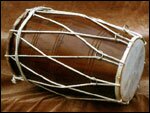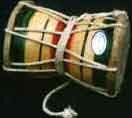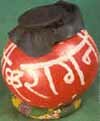|
 DHOLAK: The Dholak is a small percussive instrument often used by women and professional musicians. The main body of the Dholak is a shell made of wood and the heads are mounted with skin. A rope are thread is passed around the shell and over the braces to adjust the pitch of sound produced by striking the faces of the skin with hands to produce beats. Some times two sticks are tied to a finger or a ring is put around the thumb to produce an additional effect. DHOLAK: The Dholak is a small percussive instrument often used by women and professional musicians. The main body of the Dholak is a shell made of wood and the heads are mounted with skin. A rope are thread is passed around the shell and over the braces to adjust the pitch of sound produced by striking the faces of the skin with hands to produce beats. Some times two sticks are tied to a finger or a ring is put around the thumb to produce an additional effect.
DHOL: An instrument similar to Dholak but bigger is the Dhol. It is played by men using two sticks. The Dhol is slung in the front from the neck using a string. The loud sound of a big Dhol can be heard a great distance.
 DAMRU: It is a small palm-held drum with strings attached to beads which strikes the sides when shaken to produce the sound. DAMRU: It is a small palm-held drum with strings attached to beads which strikes the sides when shaken to produce the sound.
DERU: Deru is a Dholak type percussive instrument made of a wooden shell and skin mounted on both sides. In fact, it is a large Damru, which is struck with sticks to produce rhythmic beats. Deru is used by folk performers as well as wandering devotees.
 CHIMTA: It is a twang like instrument made of two long metallic strips joined on one side. The strips are often embellished with rings, which produce tinkling sounds when the Chimta is played. To produce percussive sounds, one holds the joint in one hand and plays strips between the fingers by striking one with the other. The Chimta is used as an accompaniment in folk musical performances. CHIMTA: It is a twang like instrument made of two long metallic strips joined on one side. The strips are often embellished with rings, which produce tinkling sounds when the Chimta is played. To produce percussive sounds, one holds the joint in one hand and plays strips between the fingers by striking one with the other. The Chimta is used as an accompaniment in folk musical performances.
 BEEN: This wind instrument is used primarily by the snake charmers. It is said that the snake charmers charm the snakes using the Been's haunting music. But it has found its permanent place now, in Haryanavi dances too. Made from dried pumpkin, it has two joints pipes to produce different notes. The player of Been has to produce continuous flow of air by breathing into it. It is a difficult instrument to play and requires very good breath control. BEEN: This wind instrument is used primarily by the snake charmers. It is said that the snake charmers charm the snakes using the Been's haunting music. But it has found its permanent place now, in Haryanavi dances too. Made from dried pumpkin, it has two joints pipes to produce different notes. The player of Been has to produce continuous flow of air by breathing into it. It is a difficult instrument to play and requires very good breath control.
 MANJIRA: Manjiras (cymbals) are made of brass and is either flat or cup shaped. These are used in pairs of different sizes and shapes. They are played in classical as well as folk and devotional music as an accompaniment. Two cymbals are tied together with a long chord and are struck with each other on the front sides to produce very pleasant tinkling sounds. MANJIRA: Manjiras (cymbals) are made of brass and is either flat or cup shaped. These are used in pairs of different sizes and shapes. They are played in classical as well as folk and devotional music as an accompaniment. Two cymbals are tied together with a long chord and are struck with each other on the front sides to produce very pleasant tinkling sounds.
 HARMONIUM: A musical instrument, also called Bajja, with keys, metal reeds and bellows. It is played by using the bellows to force air through the reeds, which are opened by fingering the keys. HARMONIUM: A musical instrument, also called Bajja, with keys, metal reeds and bellows. It is played by using the bellows to force air through the reeds, which are opened by fingering the keys.
 GHARAH: Also called the matka, it is a simple earthen pitcher and is used as an accompaniment to provide rhythm with folk singing. The open mouth is covered with stretched rubber and is played with a small stick. Raagni singers often use it with Nagara and Dholak to complement the musical beat. GHARAH: Also called the matka, it is a simple earthen pitcher and is used as an accompaniment to provide rhythm with folk singing. The open mouth is covered with stretched rubber and is played with a small stick. Raagni singers often use it with Nagara and Dholak to complement the musical beat.
 SAARANGI: A type of string instrument which is played with a bow. SAARANGI: A type of string instrument which is played with a bow.
 KHARTALS: Khartals-wooden cymbals are two pieces of hard wood made flat on one side and round on the other. Fixed in the fingers of one hand the flat surfaces are struck with each other to produce percussive sounds. Some times small bells or metallic rings are also fixed at the back of each Khartal to produce a tinkling effect. KHARTALS: Khartals-wooden cymbals are two pieces of hard wood made flat on one side and round on the other. Fixed in the fingers of one hand the flat surfaces are struck with each other to produce percussive sounds. Some times small bells or metallic rings are also fixed at the back of each Khartal to produce a tinkling effect.
 SHEHNAI: It is a flute-like instrument played mainly at weddings. SHEHNAI: It is a flute-like instrument played mainly at weddings.
 BANSURI: A flute like wind instrument consisting of a cylindrical bamboo tube played by blowing across a hole near one end. The tune is played by fingering the holes and keys along its length. BANSURI: A flute like wind instrument consisting of a cylindrical bamboo tube played by blowing across a hole near one end. The tune is played by fingering the holes and keys along its length.
SHANKH: A conch shell.
|
|